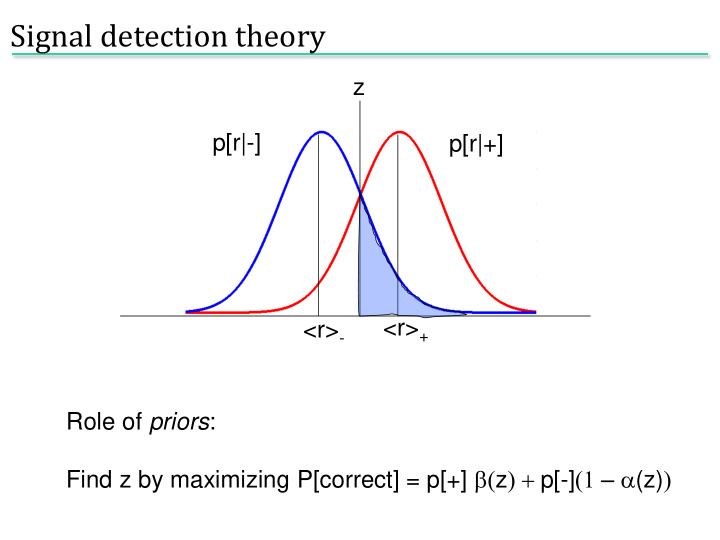



Signal detection theory z p[r|-] p[r|+] <r> + <r> - Role of priors : Find z by maximizing P[correct] = p[+] b( z ) + p[-] (1 – a (z) )
Is there a better test to use than r ? z p[r|-] p[r|+] <r> + <r> - The optimal test function is the likelihood ratio , l(r) = p[r|+] / p[r|-]. (Neyman-Pearson lemma)
Building in cost Penalty for incorrect answer: L + , L - For an observation r, what is the expected loss ? Loss + = L + P[-|r] Loss - = L - P[+|r] Cut your losses: answer + when Loss + < Loss - i.e. when L + P[-|r] < L - P[+|r]. Using Bayes’, P[+|r] = p[r|+]P[+]/p(r); P[-|r] = p[r|-]P[-]/p(r); l(r) = p[r|+]/p[r|-] > L + P[-] / L - P[+] .
Decoding from many neurons: population codes • Population code formulation • Methods for decoding: population vector Bayesian inference maximum likelihood maximum a posteriori • Fisher information
Cricket cercal cells
Population vector RMS error in estimate Theunissen & Miller, 1991
Population coding in M1 Cosine tuning: Pop. vector:
Is this the best one can do? The population vector is neither general nor optimal. “Optimal”: make use of all information in the stimulus/response distributions
Bayesian inference Bayes ’ law: likelihood function conditional distribution prior distribution a posteriori distribution marginal distribution
Bayesian estimation Want an estimator s Bayes Introduce a cost function, L(s,s Bayes ); minimize mean cost. For least squares cost, L(s,s Bayes ) = (s – s Bayes ) 2 . Let’s calculate the solution..
Bayesian inference By Bayes ’ law, likelihood function a posteriori distribution
Maximum likelihood Find maximum of p[r|s] over s More generally, probability of the data given the “model” “Model” = stimulus assume parametric form for tuning curve
Bayesian inference By Bayes ’ law, likelihood function a posteriori distribution
MAP and ML ML: s* which maximizes p[r|s] MAP: s* which maximizes p[s|r] Difference is the role of the prior: differ by factor p[s]/p[r]
Comparison with population vector
Decoding an arbitrary continuous stimulus Many neurons “voting” for an outcome. Work through a specific example • assume independence • assume Poisson firing Noise model: Poisson distribution P T [k] = ( l T) k exp(- l T)/k!
Decoding an arbitrary continuous stimulus E.g. Gaussian tuning curves .. what is P(r a |s)?
Need to know full P[ r |s] Assume Poisson: Assume independent: Population response of 11 cells with Gaussian tuning curves
ML Apply ML: maximize ln P[ r |s] with respect to s Set derivative to zero, use sum = constant From Gaussianity of tuning curves, If all s same
MAP Apply MAP: maximise ln p[s| r ] with respect to s Set derivative to zero, use sum = constant From Gaussianity of tuning curves,
Given this data: Prior with mean -2, variance 1 Constant prior MAP:
How good is our estimate? For stimulus s, have estimated s est Bias: Variance: Mean square error: Cramer-Rao bound: Fisher information (ML is unbiased: b = b ’ = 0)
Fisher information Alternatively: Quantifies local stimulus discriminability
Fisher information for Gaussian tuning curves For the Gaussian tuning curves w/Poisson statistics:
Are narrow or broad tuning curves better? Approximate: Narrow tuning curves are better Thus, But not in higher dimensions! ..what happens in 2D?
Fisher information and discrimination Recall d' = mean difference/standard deviation Can also decode and discriminate using decoded values. Trying to discriminate s and s+ D s: Difference in ML estimate is D s (unbiased) variance in estimate is 1/I F (s).
Limitations of these approaches • Tuning curve/mean firing rate • Correlations in the population
The importance of correlation Shadlen and Newsome, ‘98
The importance of correlation
The importance of correlation
Entropy and Shannon information Model-based vs model free
Recommend
More recommend